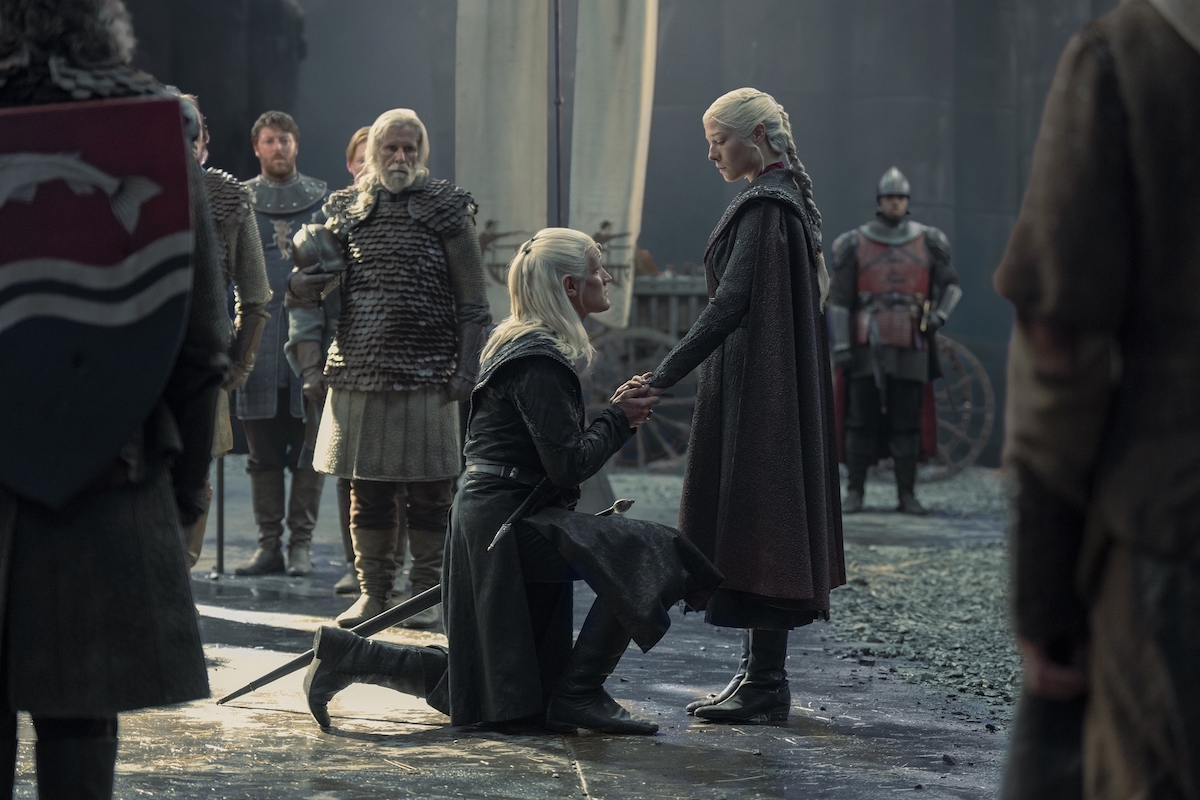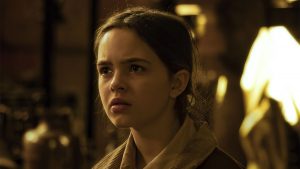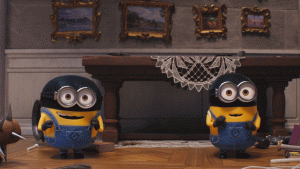
The following contains spoilers for both House of the Dragon season 2 and George R. R. Martin’s Fire & Blood
House of the Dragon isn’t a show that’s particularly concerned with things like romance. Though marriage, children, and family lineage are important political tools for its various factions and families (and spouses an occasional roadblock to be tossed aside in pursuit of a better offer or improved position) this isn’t a story about grand love affairs. That goes double for the Targaryen clan. Part of that is likely due to the family’s centuries-old habit of intermarriage—-after all, if you’re going to be automatically wed off to a brother or an aunt or a cousin, there’s little need for meeting new people or dating around.
Some couples have made the best of an arranged situation—despite his apparent endless infidelities Corlys Velaryon (Steve Toussaint) and Rhaenys Targaryen (Eve Best) found a genuine love match, and although King Viserys I (Paddy Considine) ultimately ranks the prospect of a male heir over the life of his wife, he also seems to truly care for Aemma (Sian Brooke) and mourns her death. But, let’s face it, none of these relationships are exactly romances of legend. Even House of the Dragon’s arguably best couple, Daemon (Matt Smith) and Rhaenyra Targaryen (Emma D’Arcy), share a relationship that’s frequently combative and sometimes downright toxic. But it’s obvious that the two love one another desperately, even if that love can sometimes express itself in dark and dangerous ways.
Ambitious, calculating, passionate, and occasionally cruel, Daemon and Rhaenyra have always been more like one another than any other characters on the canvas. They have not always agreed with one another, but they have always felt like they fit together, from their penchant for speaking High Valryian to their mutual disregard for things like established rules and societal norms. Yes, she has struggled to trust him and he has often chafed under the knowledge that he’s her subject as well as her husband, but the two understand one another on a level no other partner has ever matched. Plus, in the world of Westeros, a guy who’s willing to casually commit child murder to avenge your grief is probably someone you want on your side. Just saying.
Daemon and Rhaenyra are not just two of House of the Dragon’s most important characters, they’re also the foundation of the Targaryen family as Game of Thrones fans will one day know it. The matriarch and patriarch (as well as a few other relationships, all the incest makes it kind of complicated) an unbroken family line that extends hundreds of years after their deaths, their love story is essentially what makes much of the story of Westeros—and the Song of Ice and Fire—possible. Their legacy lives on through their many descendants, but it is their sixth great-granddaughter’s name most people will recognize—Daenerys Targaryen (Emilia Clarke).
However, even if you didn’t know that Dany was directly related to Daemon and Rhaenyra, you probably could have guessed it from the many parallels between the three of them, and the traits that the Mother of Dragons almost certainly inherited from her famous great-grandparents.
A Great Passion
No matter how you feel about Daemon and Rhaenyra’s relationship, it’s difficult to deny that the two are absolutely obsessed with one another. Their attraction has been obvious since Rhaenyra was a teenager, and their subsequent flirtation and courtship are full of various flavors of angst, violence and mysteriously disappearing spouses. Though both of them have moments where they’re overtly cruel to one another, it’s equally obvious their romantic affection is genuine and real. And there’s something darkly romantic about the two of them choosing each other after multiple marriages made for politics and convenience.
Daenerys loves equally fully and furiously. Though her marriage with Dothraki leader Khal Drogo (Jason Momoa) starts as a political match—she’s essentially sold to him by her brother Viserys—their bond becomes something much more. The pair become devoted to each other, so much so that Dany even turns to blood magic to try and save Drogo’s life. (She ends up having to kill him in the end, but what great love story isn’t laced with a bit of grand tragedy?) Her subsequent relationship with Jon Snow ticks the traditional Targaryen incest box, and their love match has all the weight of prophecy and destiny behind it. It’s rare that someone gets one great love affair in a lifetime, but Dany actually manages two of them. She clearly gets that from her great-grandparents.
Badass Dragonriding Skills
Since dragons died out about a hundred and fifty years before Daenerys was born, she wouldn’t have grown up in the same way her Targaryen ancestors did, learning to ride dragons at fairly young ages. Yet, when she eventually climbs aboard Drogon in Game of Thrones Season 5, she’s a natural, managing to ride the largest of her dragons without even a saddle to hang onto.
Daemon is considered one of the greatest dragon riders in the history of Westeros, and he and his dragon Caraxes ultimately bring down Vhagar, though both of them are killed in the process. Rhaenyra, for her part, is the youngest dragon rider in Targaryen history, climbing aboard Syrax when she was just seven years old. It would seem Daenerys has been blessed when more than a bit of her ancestors’ abilities.
Daemon’s Cruelty
At his best, Daemon Targaryen is a charming, incredibly complex man who is ambitious, brave, and loyal. But he’s also capable of incredible darkness—from his frequent selfishness and casual violence toward women to his penchant for murder. He holds grudges, schemes constantly, and repeatedly makes chaotic plays for power, even against the very people claims to support. He’s certainly not the worst Targaryen in this regard (Maegor the Cruel says hello!) and a lot of his ugliest traits are at least somewhat balanced out by the fact that he genuinely seems to love both Rhaenyra and his children, but when Daemon decides to unleash his worst self, it’s a lot. (See also: The Blood and Cheese incident.)
His six times great-grandaughter is similarly capable of great cruelty when she feels it’s justified. Daenerys’ worst deed is the burning of Kings Landing, likely killing tens of thousands of innocent people in her quest to sack and punish the city, but that’s hardly the first time her anger got the best of her. She takes a sadistic joy in Khal Drogo’s murder of her (admittedly, abusive) brother by dumping molten gold over his face. She gleefully burns the witch Mirri Maz Duur and crucifies over 150 random Meereenese aristocrats in retaliation for the (again, admittedly, horrific) actions of the city’s leaders. She feeds people—some likely innocent—to Rhaegal and Viserion in response to the Sons of the Harpy attack. But Dany believes herself to be the rightful queen of Westeros, and in that is justified in crushing her enemies. By whatever means necessary.
Rhaenyra’s Care for the Smallfolk
Throughout most of House of the Dragon’s run thus far Rhaenyra Targaryen has been resistant to full-on war. There are many reasons for this: choosing sides will literally tear her family apart, unleashing the dragons to maim and kill one another (as well as anyone standing in their way) is a generally bad idea, and her awareness of the bigger concerns that revolve around Aegon’s Song of Ice and Fire prophecy means that she knows this is a conflict with potentially generational stakes attached. That she does her best to prevent fighting and minimize collateral damage, even after her own son is brutally murdered by Aemond (Ewan Mitchell) and Vhaegar is a credit to her, and stems from a genuine care for the realm and all the people in it.
Rhaenyra has always had a special affection for the smallfolk of Westeros. Known as the Realm’s Delight as a child, she was generally liked by the common people and seen as the rightful heir to the throne. Her desperation to prevent thousands of pointless deaths is driven in large part by the fact that she knows that in a war between dragons, it is the people with the least who will undoubtedly suffer the most. Her half-brother Aegon, in contrast, favors more tyrannical policies of heavy taxation and deprivation, meaning that the smallfolk of Kings Landing often had to struggle to find food while watching processions of provisions meant to feed the king’s dragons pass them by. Was Rhaenyra’s decision to send food into Kings Landing politically motivated? Of course, but it also helped keep her people fed.
Similarly, Daenerys has a unique rapport with the smallfolk of both Westeros and Essos. She sees them as those who are most oppressed by the ruling elite and vows to “break the wheel” that keeps them all in chains (whether literal or figurative). She has seen the suffering of the common folk up close and it has made her empathetic to their plight, a belief which is reflected in her actions from killing slave masters and freeing their captives to chaining up her own dragons when one of them eats a local farmer. Dany fights to free slaves and feed the impoverished, so it’s not hard to see why the smallfolk would love her for that. And it’s ultimately what makes her decision to kill so many innocents in Kings Landing even more horrifying than it would have been otherwise.
A Trio of Literal Dragons
In, “The Burning Mill,” the third episode of House of the Dragon’s second season, Rhaenyra sends her step-daughter, Rhaena (Phoebe Campbell) to escort her youngest children off of Dragonstone to safety. They’re meant to journey first to the Vale and Lady Jeyne Arryn’s (Amanda Collins) keep before hopefully continuing on across the Narrow Sea to Pentos. But in addition to Rhaenyra’s young sons Aegon and Viserys and their fledgling dragons Veraxes and Stormcould, Rhaena is also carrying a different type of special cargo: four dragon eggs.
One of them is destined to hatch into her dragon, Morning. (Though the fact that in the world of the show, Rhaena seems to be about to bond with the wild dragon Sheepstealer, that may or may not be what’s going to happen onscreen.) But the other three, one gold, one green, and one reddish-black, may have a very different destiny ahead. After all, three eggs sporting those same colors are given to Danyerys as a wedding gift by Illyrio Mopatis, and ultimately hatch into Drogon, Rhaegal, and Viserion after she later carries them into her husband’s funeral pyre.
Though the House of the Dragon showrunner Ryan Cordal has said these three eggs turning out to be Dany’s dragon is but “one possible future” indicated by the conflicting sources that comprise Fire & Blood’s history, the symmetry of Rhaenyra quite literally helping her most famous descendant bring dragons back to the world is surprisingly meaningful.
A Prophesied Destiny
One of the more interesting changes in House of the Dragon is the decision to reimagine Aegon the Conqueror not just as a great warrior who united the Seven Kingdoms, but a dreamer who could see the future—who specifically saw the Long Night that would come to pass in Game of Thrones. It is Aegon’s dream that is passed down from Targaryen ruler to heir through the centuries as the Song of Ice and Fire, a family prophecy and promise that a member of the blood of the dragon would be necessary to save Westeros from a coming monstrous darkness. Well, he got most of it right. Eventually. Sort of.
Game of Thrones was pretty cagey about the identity of the legendary Prince That Was Promised, never fully revealing a definitive answer about their identity, beyond revealing that the Valyrian word for “prince” is gender-neutral. There’s an argument to be made that it’s Jon Snow (Kit Harington), a combination of Stark and Targaryen bloodlines who both died and was resurrected. Or possibly Arya Stark (Maisie Williams), considering that she’s the person who killed the Night King. But the most obvious answer has always been the one House of the Dragon is so keen to embrace (or retcon, depending on your perspective): Daenerys.
True, Dany never truly claimed the Iron Throne in Game of Thrones. If you want to get technical about it, there was no Targaryen ruler during the Long Night or the series’ final conflict with the White Walkers. But it was ultimately her decision to walk into Khal Drago’s funeral pyre that brought dragons back into the world, giving the Seven Kingdoms a fighting chance against the White Walkers and their legions of the dead. That’s kind of a big deal, and precisely the sort of thing a person of destiny might do. Plus, if Dany really is the Prince That Was Promised, it also explains her fire immunity, technically a power no other Targaryen, not even her powerful six times great-grandparents ever possessed.
The post What Daenerys Targaryen Inherited From House of the Dragon’s Daemon and Rhaenyra appeared first on Den of Geek.







